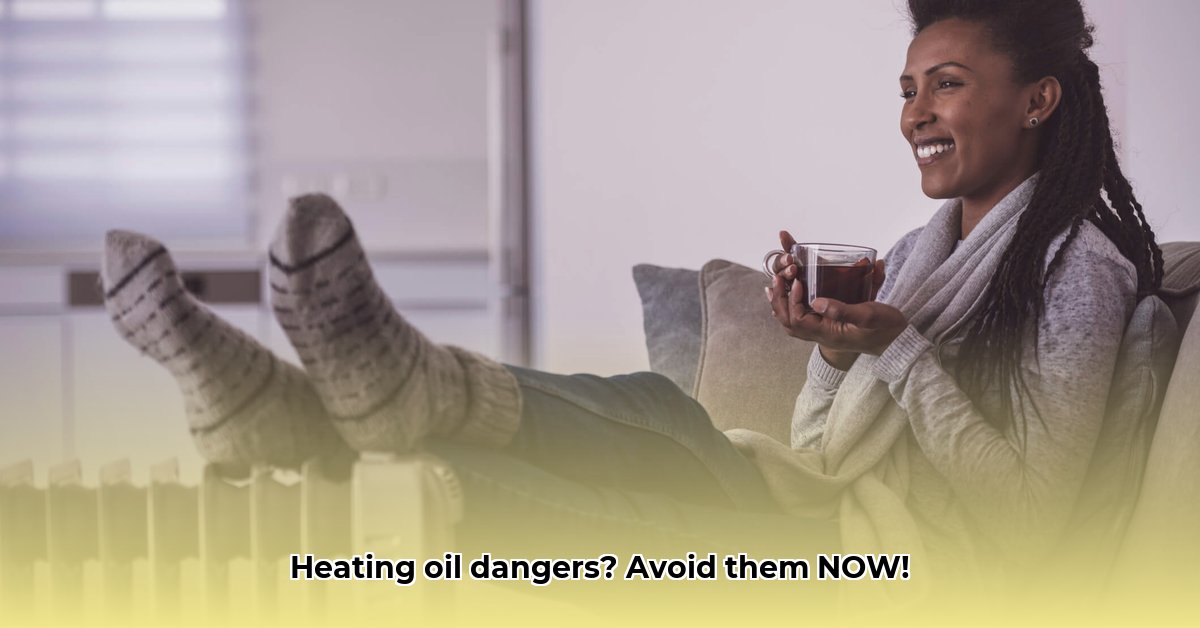Keeping your home warm with heating oil is a great way to combat the winter chill, but prioritizing safety is paramount. Heating oil systems, while efficient, can present risks if mishandled. This guide offers simple, yet vital steps to safeguard you and your family throughout the winter season, incorporating expert advice and best practices.
Home Heating Oil Safety and Maintenance
Let’s delve into essential safety measures concerning your home heating oil setup, including proactive maintenance and understanding potential hazards related to oil heating systems. Knowledge is power when it comes to preventing accidents and ensuring efficient operation.
Inspecting Your System: A Yearly Check-Up by a Qualified Technician
Treat your heating oil system like your car – it thrives on regular maintenance. A yearly professional inspection stands as your premier defense against potential issues. This checkup should encompass a comprehensive examination of the entire system: the tank, burner, and pipes transporting oil and exhaust. Trained technicians search for leaks, rust, corrosion, and any signs of damage that could lead to trouble, such as weakened fuel lines or loose fittings. Proactive maintenance prevents costly and dangerous surprises, prolongs the lifespan of your equipment, and ensures optimal efficiency.
Before the heating season, schedule an inspection with a certified technician. A thorough inspection includes:
- Tank assessment: Checking for rust, dents, and leaks.
- Burner efficiency test: Ensuring proper combustion and minimizing emissions.
- Ventilation check: Verifying adequate airflow for safe operation.
- Piping inspection: Examining fuel lines for damage or deterioration.
Preventing Carbon Monoxide (CO) Poisoning: The Silent Danger Demands Vigilance
Carbon monoxide (CO) is a sneaky killer – invisible, odorless, and deadly. That’s why carbon monoxide detectors on every level of your home are essential, especially near sleeping areas. Test detectors monthly, and replace batteries at least twice a year, or as recommended by the manufacturer. Consider detectors with digital displays showing CO levels for added safety.
Besides detectors, proper ventilation is key. Ensure vents are clean and working correctly to allow harmful CO to escape your home. Clogged vents pose a significant CO risk. Never block or obstruct vents, and regularly inspect them for debris or obstructions.
Symptoms of CO poisoning include:
- Headache
- Dizziness
- Nausea
- Vomiting
- Confusion
- Weakness
- Loss of consciousness
If anyone in your household experiences these symptoms, evacuate immediately and call emergency services.
Fire Safety: Simple Steps, Significant Impact
Fire is a significant concern with any heating system, especially one using fuel. This is where straightforward prevention steps make a huge difference. Keep flammable materials like paint, cleaning supplies, gasoline, and other chemicals far from your oil tank and furnace, storing them in a separate, well-ventilated area. A distance of at least three feet is recommended.
Keep a multi-purpose fire extinguisher (rated for Class B fires, which involve flammable liquids) near your heating system, and understand how to use it. Familiarize yourself with the PASS acronym: Pull, Aim, Squeeze, Sweep.
- Pull the pin.
- Aim at the base of the fire.
- Squeeze the lever slowly and evenly.
- Sweep from side to side until the fire is extinguished.
Have your chimney inspected and cleaned annually by a qualified professional to prevent blockages and ensure proper venting of combustion gases. A blocked chimney can lead to carbon monoxide buildup, a potentially deadly hazard.
Addressing Oil Leaks: Spotting and Stopping Problems Immediately
Oil leaks pose a danger to the environment and safety. Regularly inspect your tank, fuel lines, and pipes for any signs of leaks, even tiny drips or oil smells. A tiny unattended leak can quickly escalate into a larger, more costly issue, contaminating soil and potentially groundwater.
If you see a leak, no matter how small, immediately call a qualified professional. Do not attempt to clean up a large spill yourself.
Signs of an oil leak include:
- A strong oil odor
- Visible oil stains on the ground or tank
- Damp spots around the tank
- A sudden increase in oil consumption
- Loss of vegetation near the tank
Environmental Responsibility: Doing Your Part for a Sustainable Future
Used heating oil requires proper disposal to protect our environment. Never pour used oil down the drain or onto the ground. Many communities offer recycling programs for used oil – check with your local waste management services to find out your options. Some heating oil suppliers also offer used oil collection services. Responsibly disposing of used oil protects the environment and ensures a cleaner, safer future for everyone. Contact your local waste management authority for guidance on the correct procedure, ensuring the safe handling of waste oil.
Bioheat, a blend of traditional heating oil and biodiesel made from renewable resources, is a more environmentally friendly alternative to traditional heating oil. Consider switching to bioheat to reduce your carbon footprint.
Emergency Preparedness: Your Action Plan Saves Lives
While preventative maintenance minimizes risks, it is wise to have an emergency plan. Knowing what to do if a leak occurs or your CO detector goes off can make all the difference. Keep emergency contact information handy – numbers for your oil supplier, fire department, and other relevant services. Make sure everyone in your household knows the plan, including evacuation routes and meeting points. Conduct regular fire drills to practice your emergency plan.
Emergency contact information should include:
- Your heating oil supplier
- Your local fire department
- Your local emergency services
- A qualified heating system technician
- Your insurance company
A Simple Checklist for Peace of Mind
Summarizing essential heating oil safety tips into a handy checklist:
| Task | Frequency | Importance |
|---|---|---|
| Professional System Inspection | Annually | Prevents major issues, identifies potential hazards early on. |
| CO Detector Check | Monthly, and test batteries frequently. | Essential for detecting the invisible, odorless threat of carbon monoxide. |
| Ventilation Check | Regularly (at least seasonally) | Ensures proper air flow to prevent CO buildup. |
| Flammable Material Storage | Maintain safe distance from equipment | Prevents accidental fires. |
| Fire Extinguisher Check | Annually, or as recommended by manufacturer | Ensures it is ready for use in case of an emergency. |
| Tank & Pipe Inspection | Monthly | Early detection of leaks prevents environmental damage and safety issues. |
| Emergency Plan | Establish and review annually | Crucial for responding effectively to unexpected events. |
| Oil Disposal | As needed | Protects the environment and adheres to local regulations. |
Following these simple steps can significantly reduce the risks associated with home heating oil. Remember, it’s an investment in the safety and well-being of your family and your home. Start practicing these safety tips today! Regular inspections are crucial for how to prevent home heating oil tank leaks and spills.
How to Prevent Home Heating Oil Tank Leaks & Spills: A Comprehensive Guide
Maintaining a safe heating oil system begins with preventing leaks and spills, safeguarding your home and the local environment.
Prevention is always better than cure, and with heating oil tanks, it’s also much cheaper than remediation. A proactive approach not only protects your property and the environment but also ensures the continued efficient operation of your heating system.
Key Takeaways:
- Regular inspections are crucial for preventing costly accidents.
- Overfill prevention devices are a simple yet effective safety measure.
- Addressing minor issues promptly prevents them from becoming major problems.
- Professional help is essential for significant leaks or spills.
- Knowing your local regulations is vital.
Inspect Your System Regularly: More Than Just a Glance
Think of your heating oil tank like your car – regular check-ups prevent bigger problems down the road. Aim for at least a bi-annual inspection, more frequently if your tank is older (over 15 years). Look for signs of rust, corrosion (especially near the bottom of the tank), or any visible damage to the tank itself, including dents or bulges. Examine all connections for leaks; a damp spot or oil smell is a warning sign. Don’t hesitate to call a professional if you spot anything suspicious. A professional inspection includes a pressure test to check for hidden leaks.
During your inspection, pay close attention to:
- The tank’s surface: Look for any signs of rust, corrosion, dents, or bulges.
- The tank’s supports: Ensure the tank is sitting level and the supports are stable.
- The fill pipe and vent: Check for any obstructions or damage.
- The oil lines: Inspect for leaks, cracks, or damage.
- The area around the tank: Look for oil stains or any signs of leakage.
Prevent Overfilling: A Simple but Crucial Step for Spill Prevention
Overfilling is a major cause of leaks and spills. Installing an overfill prevention device, like a SpillStop valve, is a straightforward way to avoid this. These devices automatically stop the oil flow when the tank reaches its maximum capacity, providing safety and peace of mind. Ensure your oil delivery company uses an overfill prevention device during deliveries.
Consider installing a high-level alarm that sounds when the tank is nearing capacity, providing an extra layer of protection.
Maintain Your System: Small Steps, Big Impact on Longevity
Minor issues, left unattended, can lead to bigger problems. A slightly loose connection or a small crack can slowly
- Unlock Your Future: Community Colleges in Florida with Childhood Education Programs – Your Affordable Path - September 14, 2025
- Unlock Futures: Catawba College Growth Strategy Insights 2025 - September 14, 2025
- Your Complete Guide to Eastfield Community College | 2025 Programs & Insights - September 14, 2025



![Fast Track Your Legal Career: Broome Community College Paralegal Studies AAS [2025 Guide] broome_community_college_paralegal_studies_edited](https://baufinanzierung-ausland.de/wp-content/uploads/2025/08/broome_community_college_paralegal_studies_edited-150x150.jpg)











